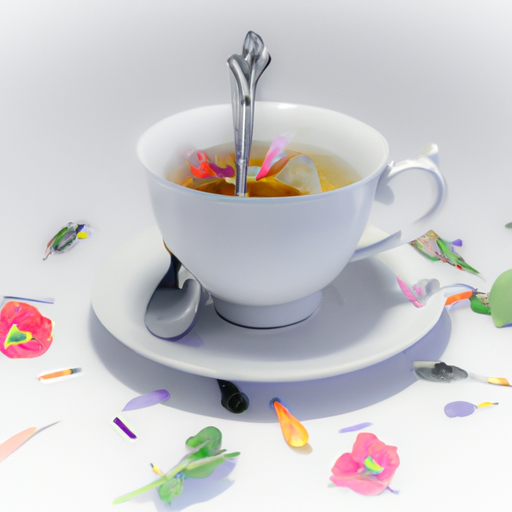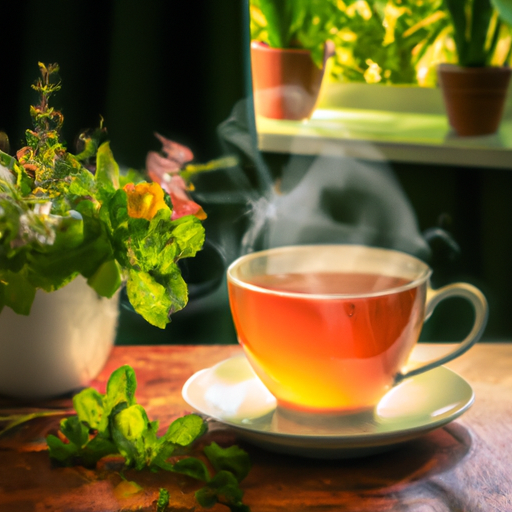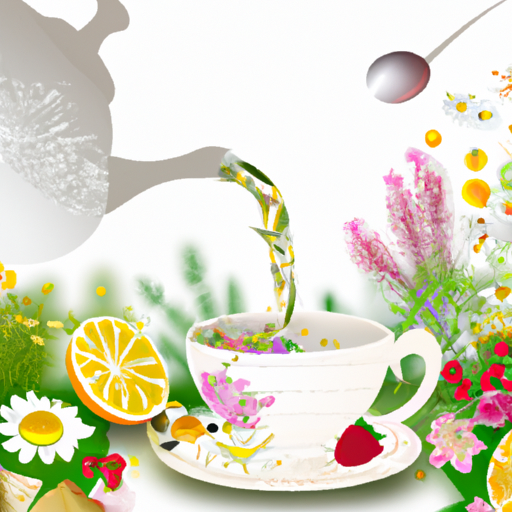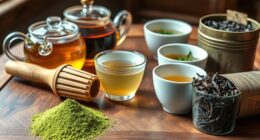Do you ever find yourself standing in the tea section, gazing at the numerous types of tea, pondering what distinguishes green tea from herbal tea? I certainly do. Tea is more than just a comforting drink; it is a time-honored tradition with a diverse history and a multitude of flavors waiting to be discovered.
Understanding the differences between green tea and herbal tea can help you make an informed choice and find the perfect cup to suit your taste and needs.
Imagine you’re in a garden, surrounded by fragrant flowers and lush greenery. Each plant has its unique character and healing properties. Green tea, with its delicate leaves, comes from the Camellia sinensis plant, while herbal tea is a blend of dried flowers, fruits, herbs, and spices. These teas not only differ in taste but also in their caffeine content, health benefits, and brewing techniques.
Join me on a journey as we delve into the origins, processing methods, and flavor profiles of green tea and herbal tea. Discover the various types of each tea and unlock the secrets to brewing a perfect cup. By the end, you’ll be equipped with the knowledge to savor every sip and harness the power of tea for your well-being.
Key Takeaways
- Green tea comes from the Camellia sinensis plant and undergoes minimal processing, while herbal tea is a blend of dried flowers, fruits, herbs, and spices.
- Green tea contains caffeine, but herbal teas are typically caffeine-free.
- Herbal teas have calming properties, can aid in weight loss, and are rich in antioxidants.
- Green tea varieties have unique flavor profiles, while herbal teas offer a wide range of flavors and aromas.
Origins and Processing Methods
When it comes to the origins and processing methods, you’ll find that there are distinct differences between green tea and herbal tea.
Green tea is derived from the leaves of the Camellia sinensis plant, which is native to China and has been cultivated for centuries. It undergoes minimal processing, with the leaves being steamed or pan-fried to prevent oxidation. This traditional technique helps retain the natural compounds and antioxidants present in the leaves.
On the other hand, herbal tea is not made from the Camellia sinensis plant but is instead a blend of various herbs, flowers, fruits, and spices. The production of herbal tea involves different methods, including drying, crushing, and blending the ingredients. Unlike green tea, herbal teas do not undergo the same traditional processing techniques. Instead, they often use modern techniques to ensure the flavors and aromas of the ingredients are enhanced.
The origins and production methods of green tea and herbal tea differ significantly. Green tea follows traditional techniques to preserve its natural compounds, while herbal tea relies on modern methods to enhance its flavors.
Caffeine Content
If you want a pick-me-up without the jitters, go for herbal tea instead of green tea. While both green tea and herbal tea offer a range of health benefits, one key difference lies in their caffeine content. Green tea contains caffeine, albeit in lower amounts compared to coffee. On the other hand, herbal teas are typically caffeine-free, making them a great option for individuals who are sensitive to caffeine or looking to reduce their intake. The table below summarizes the caffeine content in popular herbal teas compared to green tea:
| Herbal Tea | Caffeine Content |
|---|---|
| Chamomile | Caffeine-free |
| Peppermint | Caffeine-free |
| Rooibos | Caffeine-free |
| Ginger | Caffeine-free |
It is important to note that while green tea’s caffeine content can provide a gentle energy boost, it may also have potential effects on sleep, especially if consumed in large quantities or close to bedtime. Additionally, some individuals may experience side effects such as increased heart rate or digestive issues from green tea’s caffeine. Therefore, herbal teas can be a suitable alternative for those seeking a caffeine-free option with minimal potential side effects.
Health Benefits
To reap the health benefits, you’ll find a cup of herbal tea like a soothing balm for your body and mind. Here are four reasons why herbal tea is beneficial for weight loss and stress relief:
-
Natural Weight Loss Aid: Certain herbal teas, such as green tea, peppermint tea, and ginger tea, have been found to boost metabolism and aid in weight loss. These teas can increase fat oxidation and help suppress appetite, making them a great addition to a healthy diet and exercise routine.
-
Stress Relief: Herbal teas like chamomile, lavender, and lemon balm have calming properties that can help reduce stress and anxiety. They contain compounds that promote relaxation and improve sleep quality, allowing you to unwind and rejuvenate.
-
Antioxidant Power: Many herbal teas are rich in antioxidants, which help protect your cells from damage caused by free radicals. These antioxidants can support overall health and reduce the risk of chronic diseases.
-
Hydration: Herbal teas are a great way to stay hydrated, as they’re mostly water-based. Proper hydration is essential for maintaining a healthy weight and managing stress levels.
Incorporating herbal teas into your daily routine can be a simple yet effective way to support weight loss efforts and find relief from stress.
Flavor Profiles
Indulge your taste buds with a variety of flavors found in herbal teas, adding a burst of deliciousness to your daily routine. Unlike green tea, herbal teas don’t come from the Camellia sinensis plant. This allows for a wide range of taste preferences to be catered to.
From sweet and fruity to earthy and floral, there’s an herbal tea for every palate. Some popular flavors include chamomile, peppermint, hibiscus, and lavender. These teas can be enjoyed hot or iced, making them a versatile choice for any season.
Additionally, herbal teas aren’t just limited to drinking – they can also be used in culinary creations. They can be incorporated into recipes for soups, stews, and even desserts, adding a unique and refreshing twist to your dishes.
Types of Green Tea
Imagine yourself sipping on a steaming cup of matcha, a traditional Japanese green tea known for its vibrant color and earthy flavor.
Green tea comes in various types, each with its own unique cultivation techniques and flavor profiles. One popular type is sencha, which is grown in full sunlight, giving it a refreshing and grassy taste.
Another type is gyokuro, which is shade-grown, resulting in a sweeter and more umami flavor. Dragonwell, a Chinese green tea, is renowned for its chestnut-like aroma and mellow flavor.
When it comes to popular green tea brands, some well-known names include Ito En, Harney & Sons, and Tazo. These brands offer a wide range of green tea options, ensuring that there is something for everyone’s taste preferences.
Types of Herbal Tea
Now that we’ve explored the various types of green tea, let’s delve into the world of herbal tea blends. Herbal tea, unlike green tea, isn’t made from the leaves of the Camellia sinensis plant. Instead, it’s created by infusing various herbs, flowers, fruits, and spices in hot water.
Herbal tea blends offer a wide range of flavors and aromas that can cater to different preferences. They can be enjoyed hot or iced, making them a versatile beverage option.
Additionally, herbal teas are renowned for their medicinal properties. Different herbs possess unique health benefits, such as soothing an upset stomach, promoting relaxation, boosting immunity, or aiding in digestion.
To fully reap the medicinal properties of herbal tea, it’s important to select blends that align with your specific health needs. Always consult with a healthcare professional before incorporating herbal teas into your wellness routine.
Now, let’s explore three popular herbal tea blends and their unique medicinal properties:
-
Chamomile and Lavender Blend: Promotes relaxation and aids in sleep.
-
Peppermint and Ginger Blend: Relieves digestive issues and soothes stomach discomfort.
-
Hibiscus and Rosehip Blend: Rich in antioxidants and supports heart health.
Brewing Techniques
Let’s explore the art of brewing herbal tea blends using different techniques to enhance the flavors and aromas. When it comes to brewing herbal tea, there are a few key factors to consider: the type of tea variety and the infusion time. Different tea varieties have different brewing requirements to bring out their unique flavors. For example, delicate herbs like chamomile and lavender require a shorter infusion time of around 5 minutes, while stronger herbs like peppermint and ginger may need a longer infusion time of around 10 minutes. To help you understand the brewing techniques better, here’s a table summarizing the recommended infusion times for popular herbal teas:
| Herbal Tea Variety | Infusion Time |
|---|---|
| Chamomile | 5 minutes |
| Lavender | 5 minutes |
| Peppermint | 10 minutes |
| Ginger | 10 minutes |
By following the appropriate brewing techniques, you can ensure that your herbal tea bursts with the desired flavors and aromas.
Frequently Asked Questions
Are there any potential side effects or risks associated with consuming green tea or herbal tea?
While both green tea and herbal tea offer numerous health benefits, it’s important to be aware of potential risks. Some individuals may experience side effects such as insomnia, stomach upset, or allergic reactions.
Can green tea or herbal tea be consumed during pregnancy or while breastfeeding?
During pregnancy, it is generally safe to consume herbal tea in moderation, but it’s important to consult with a healthcare provider first. Green tea contains caffeine, so it should be limited while breastfeeding.
Is it true that green tea can help with weight loss?
Yes, it’s true that green tea can aid in weight loss. It has several benefits, such as boosting metabolism and increasing fat burning. However, it does contain caffeine, so it’s important to consume it in moderation.
Are there any specific storage requirements for green tea or herbal tea to maintain their freshness and flavor?
To maintain the freshness and flavor of both green tea and herbal tea, it is important to store them properly. Store them in airtight containers away from light, heat, and moisture, and use them within their recommended shelf life for the best results.
Can green tea or herbal tea help in reducing the risk of certain diseases, such as cancer or heart disease?
Green tea has been shown to reduce the risk of certain diseases, like cancer. For skin health, both green tea and herbal tea have benefits. When it comes to digestion, herbal tea may be more beneficial.
Conclusion
In conclusion, understanding the difference between green tea and herbal tea is like distinguishing between two unique characters in a captivating story.
Green tea, with its origins in China and Japan, undergoes a meticulous processing method, resulting in a delicate flavor and a moderate caffeine content.
On the other hand, herbal tea, with its diverse range of ingredients, offers a caffeine-free alternative with various health benefits and an array of flavors.
Just like in a well-crafted allegory, each tea type has its own distinct qualities, making them both intriguing and enjoyable in their own ways.










